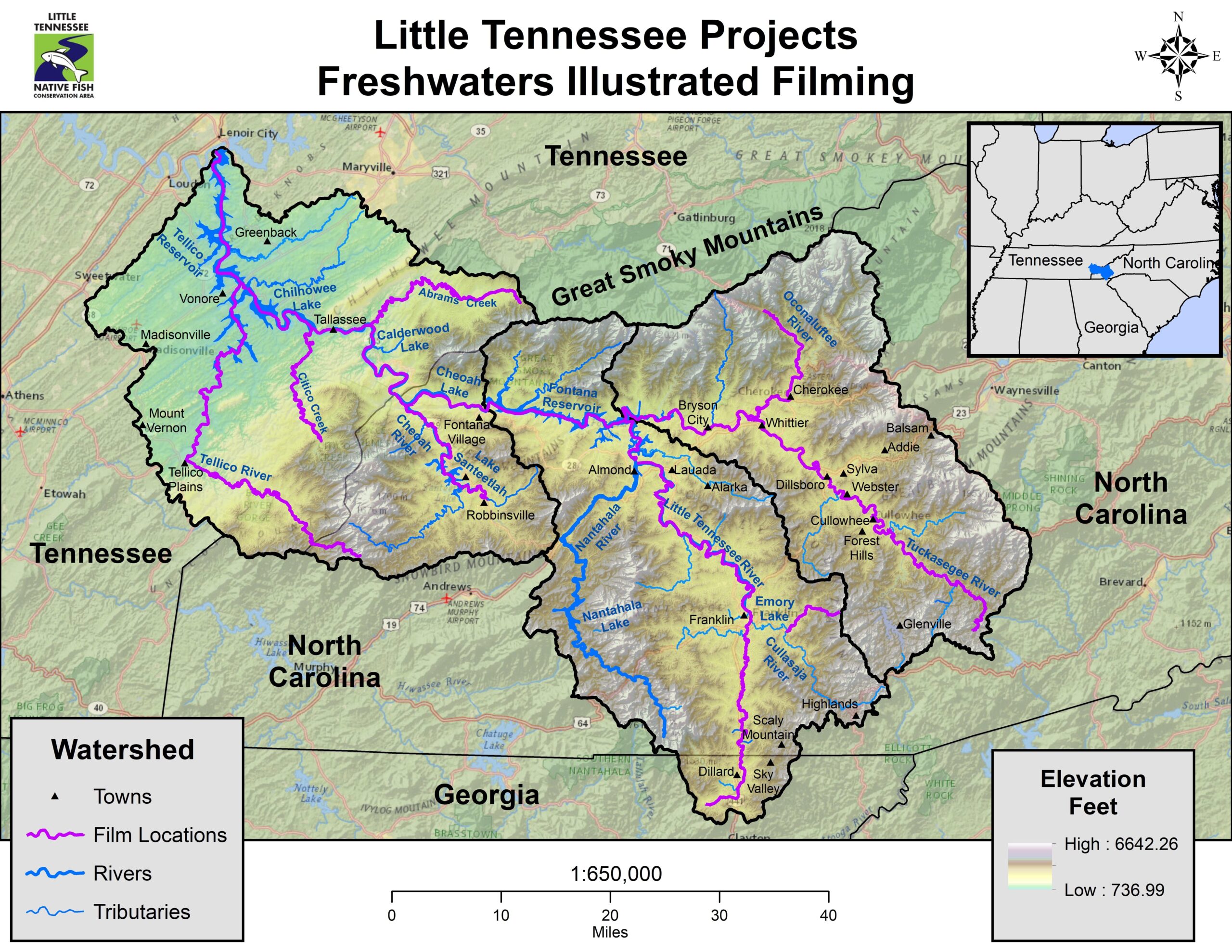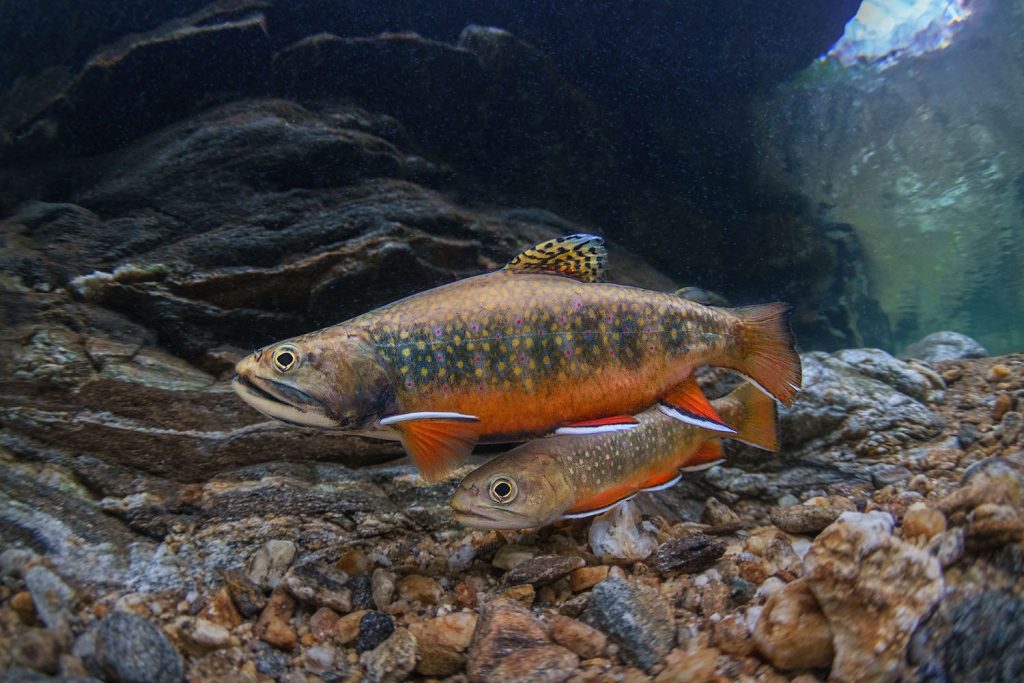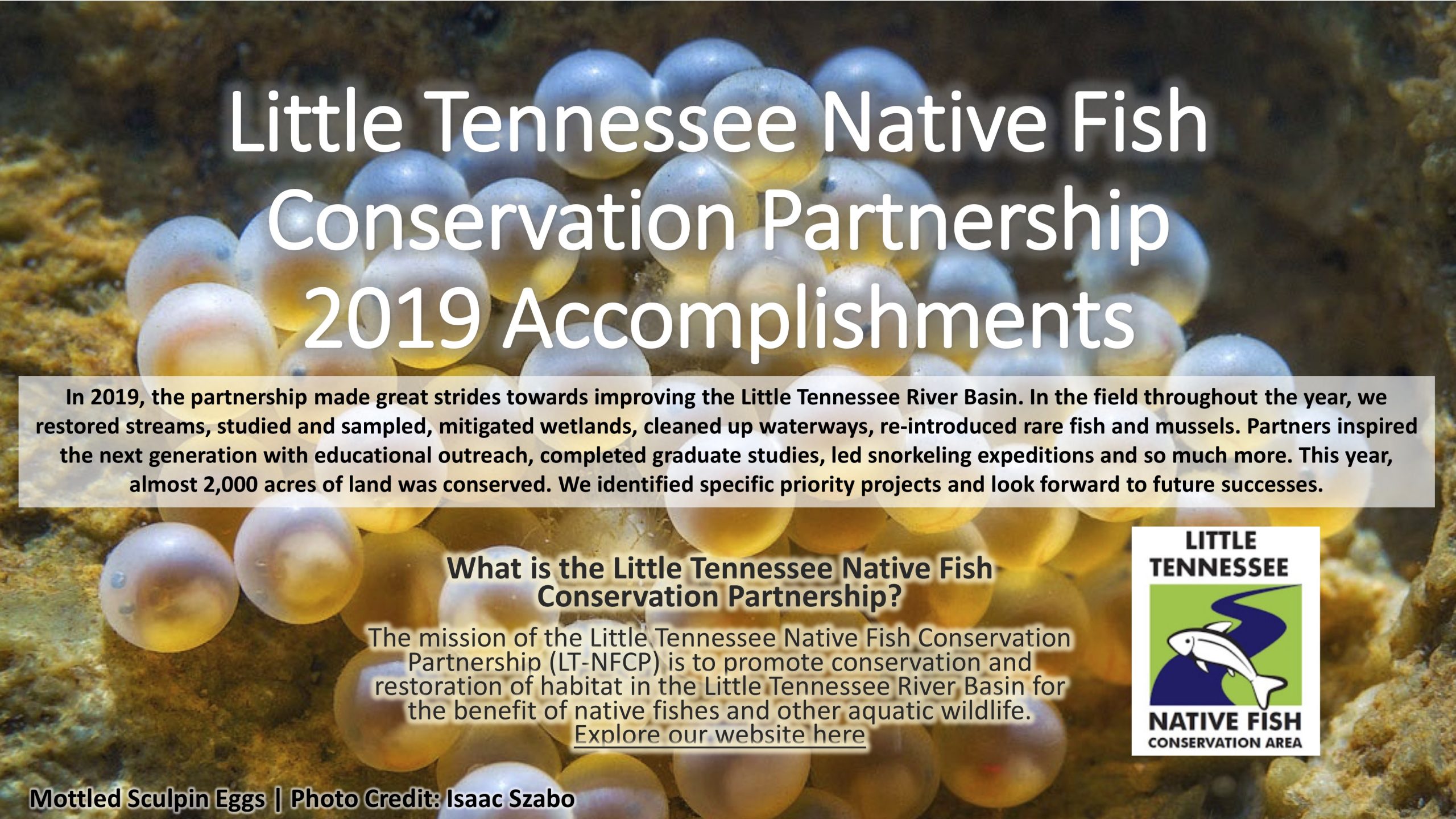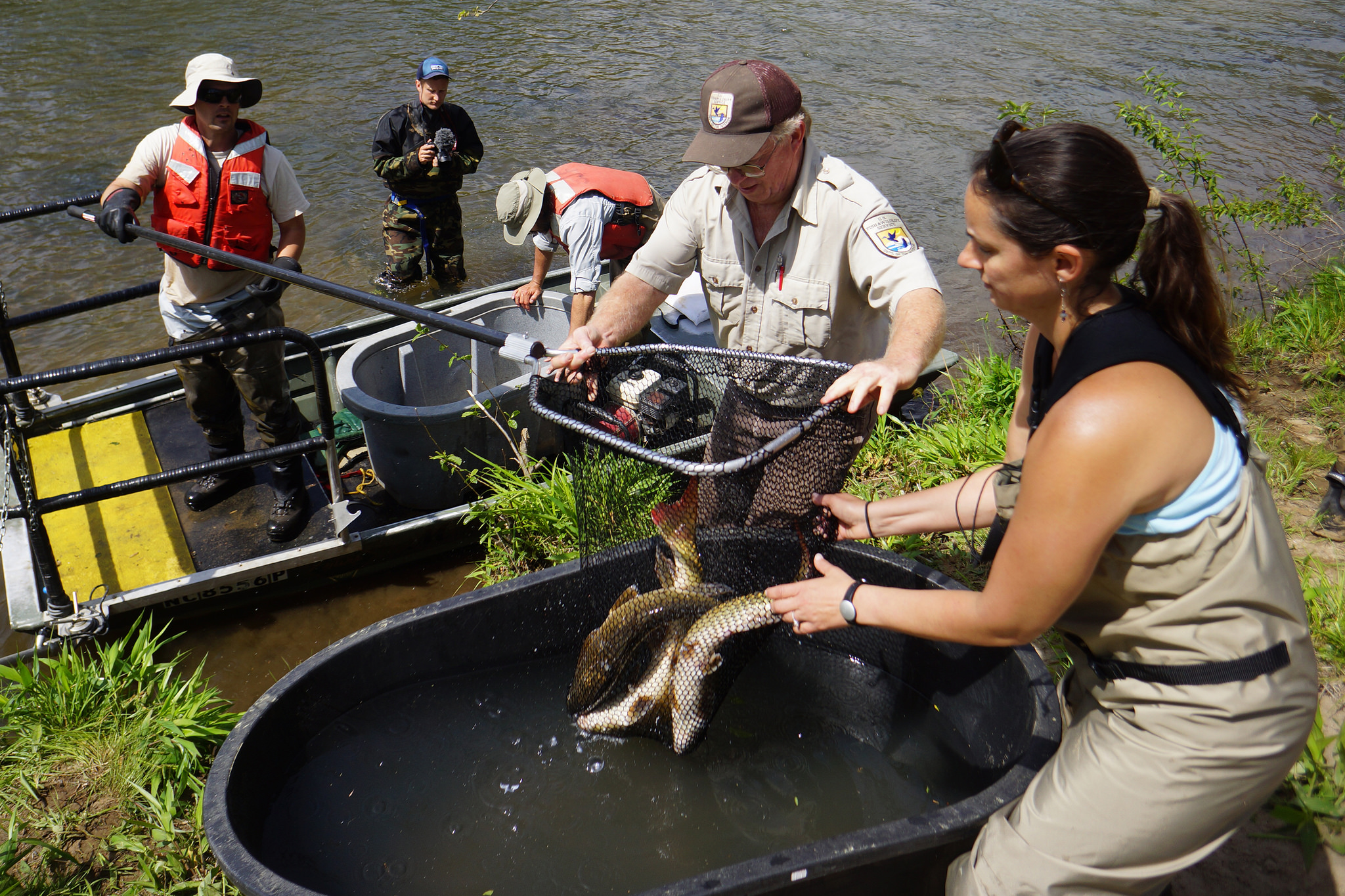Category: Archives
2020 Accomplishments
 2021 was another outstanding year for the partnership, from publishing journal articles, propagation and reintroduction of multiple fish and mussel species, restoring stream banks, Shade Your Stream tree planting events and more. View photos and read about our efforts to protect the Little Tennessee watershed here!
2021 was another outstanding year for the partnership, from publishing journal articles, propagation and reintroduction of multiple fish and mussel species, restoring stream banks, Shade Your Stream tree planting events and more. View photos and read about our efforts to protect the Little Tennessee watershed here!
Species Profile: Spotfin Chub
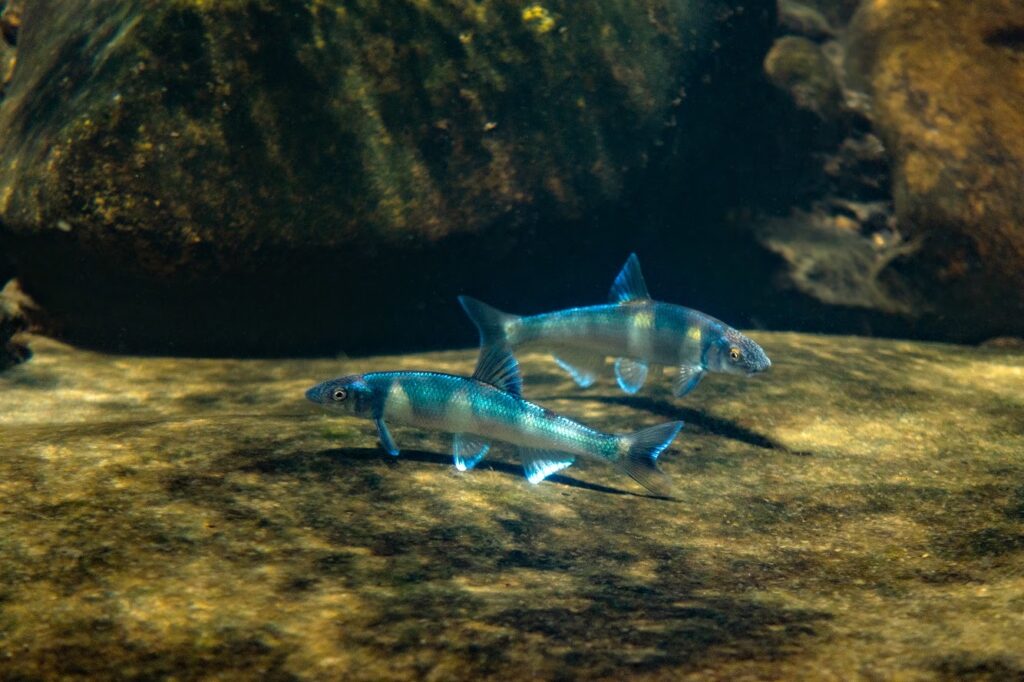
Two male Spotfin Chubs sparring to “own” a preferred spawning site. Photo by Derek Wheaton of Conservation Fisheries, Inc.
Spotfin chub (Erimonax monachus) – Federally Threatened Species
One fish, two fish, red fish, Wow! What’s that blue fish! There are very few freshwater fishes as striking as a Spotfin Chub, Erimonax monachus, in breeding colors. Spotfin Chubs are found only in the Tennessee River drainage and have a spotty distribution that includes the Little Tennessee River and tributaries in North Carolina and Tennessee, the Holston River in Southwest Virginia, the Emory River and tributaries, and the Buffalo River in Tennessee. Several populations are known to have been extirpated and some of these are the focus of ongoing (and apparently successful!) recovery efforts.
Spotfin Chubs are most often found in shallow areas in the river with bedrock and swift current. They are not very tolerant of silt and sedimentation, which is likely why some of the historic populations disappeared. The males (which, by the way, are the ones that display the electric turquoise blue coloration) stake out crevasses in the bedrock and vigorously guard these sites in hopes of attracting females with whom they will spawn.
If successful in attracting a mate, spawning will result in eggs that are deposited deep into the cracks in the rock where predators cannot easily reach them. Spawning takes place throughout much of the summer and the males continue to guard these sites, attracting more and more females that add to the growing nest. As the eggs hatch, the larvae tend to move into the slower water, often over fine sand where they grow from about an eighth of an inch to maybe an inch or more during their first year of life.
Spotfin Chubs are currently listed as Federally Threatened under the Endangered Species Act (ESA). This designation results in a Recovery Plan that describes recovery actions that, if successful could justify removing them from the protection of the ESA. According to the Spotfin Chub Recovery Plan’s recommended actions, there are several projects currently underway to restore populations into streams or stream reaches where they have disappeared. If some of these restored populations continue to show the success that appears to be effective, this remarkable fish may soon be able to be removed from that ESA list altogether.
So, next time you are in one of their streams, keep a lookout for a brilliant flash of turquoise under the water. Then, you may remember that Blue Fish you see is a Spotfin Chub!
Profile by J. R. Shute of Conservation Fisheries, Inc. Photo by Derek Wheaton of Conservation Fisheries, Inc.
This post is part of a series on the aquatic species of the Little Tennessee river basin by members of the Little T NFCP. To see all species profiles, click here. Please contact us if you’re interested in contributing!
Species Profile: Brook Trout
Brook trout or “speckled trout” (Salvelinus fontinalis)
The only trout native to the Appalachians may be more unique than we know. The scientific jury is still out as to whether our “speckled trout” are different from northern brook trout. One thing is sure – this magnificent creature is losing ground to pollution, sedimentation, deforestation and invasive species (including other trout). Every foot of stream containing brook trout merits all the protection we can give it.
Profile by Jason Meador of Mainspring Conservation Trust.
This post is part of a series on the aquatic species of the Little Tennessee river basin by members of the Little T NFCP. To see all species profiles, click here. Please contact us if you’re interested in contributing!
Video: Sicklefin Redhorse Restoration
Sicklefin redhorse — long known by the Cherokee and only recently recognized by western science — is an iconic species of the Little Tennessee watershed. Join Luke Etchison of the NC Wildlife Resources Commission to learn about science and restoration of this incredible fish.
2018 Accomplishments Report
2019 was another outstanding year for the partnership, from creating a Facebook page, publishing journal articles, propagation and reintroduction of multiple fish and mussel species, restoring stream banks, Shade Your Stream tree planting events and more. View photos and read about our efforts to protect the Little Tennessee watershed here!
2017 Accomplishments Report
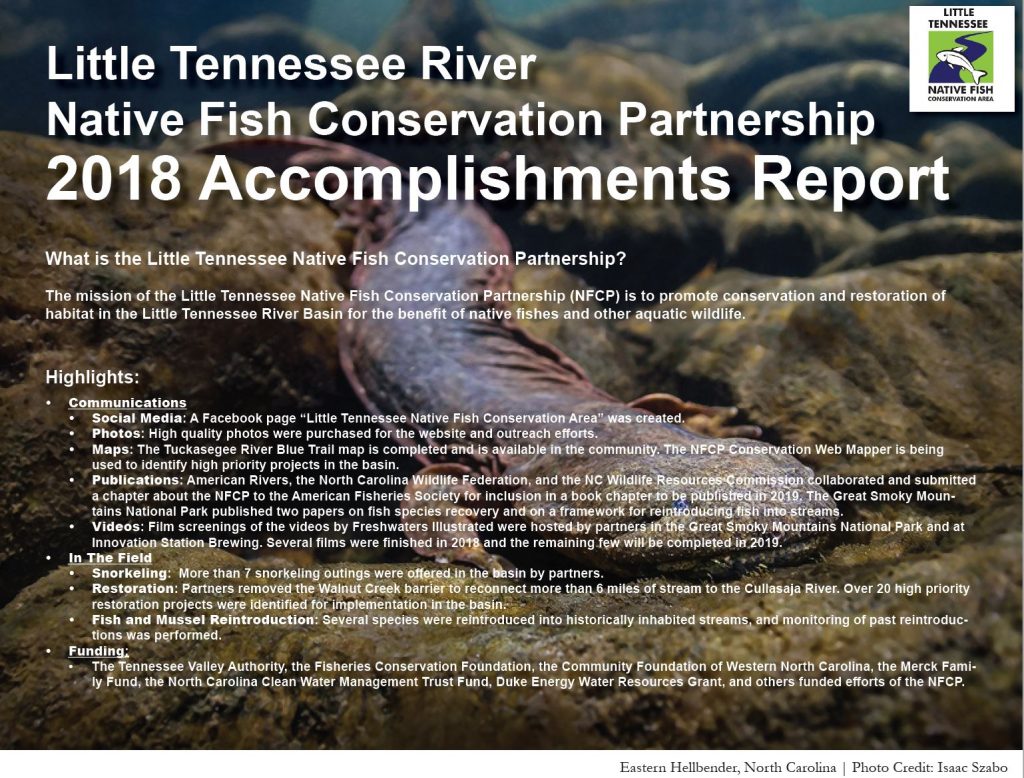
2016 Accomplishments – a big year
2017 was a tremendous year for the partnership, from getting snorkeling events going to recording video for upcoming movie shorts about the basin. Read more here.
Looking back at 2016
The partnership just produced it’s first annual accomplishment report. What a great year – from river snorkeling to fish conservation. Check it out.
Endangered Species Act protection not needed for sicklefin redhorse
The U.S. Fish and Wildlife Service concluded the sicklefin redhorse doesn’t need to be placed on the Endangered Species list. Though long recognized by the Cherokee, this fish was discovered by science in the early 1990s. It is found in Swain, Jackson, Macon, Clay, and Cherokee counties, North Carolina, and Towns County, Georgia. For several years, it has been the subject of a focused conservation effort by
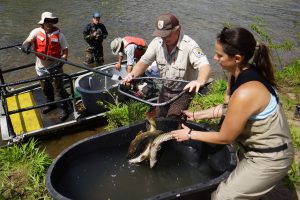 the Service, North Carolina Wildlife Resources Commission, Eastern Band of Cherokee Indians, and Conservation Fisheries, Inc. An agreement signed earlier this year formalized the partnership and brought in the Georgia Department of Natural Resources, Duke Energy, and the Tennessee Valley Authority. Read more. Read more.
the Service, North Carolina Wildlife Resources Commission, Eastern Band of Cherokee Indians, and Conservation Fisheries, Inc. An agreement signed earlier this year formalized the partnership and brought in the Georgia Department of Natural Resources, Duke Energy, and the Tennessee Valley Authority. Read more. Read more.



